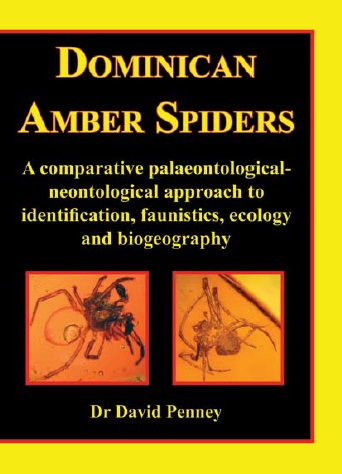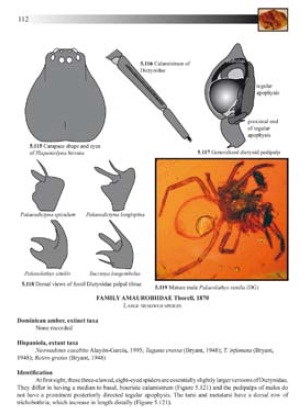|
|
|
LIBROS |
| |
|
|
| |
Dominican Amber Spiders: a
comparative palaeontological-neontological approach to identification,
faunistics, ecology and biogeography |
|
| |
David Penney |
|
|
| |
Siri Scientific Press 176 pp. 24 x 17 cm tapas blandas |
|
|
| |
88 fotos a color, 11 fotos en blanco y negro, 14 ilustrations, |
|
|
| |
224 ilustraciones en escala de grisesPrecio:
40 £ |
|
| |
ISBN 978-0-9558636-0-8 (2008) |
|
| |
|
|
| |
Este libro trata sobre las arañas de una
de las regiones poco peor estudiadas de la Tierra, la República de
Kazajstán, que se encuentra en Asia Central. Hasta ahora, no existe un
único catálogo o guía de identificación ilustrada para las arañas de
Kazakhstan. Por lo tanto, este libro constituye el primer documento
sobre ésta interesante fauna, proporcionando una descripción ricamente
ilustrada de 176 especies de arañas de 41 familias, que representan la
mayor parte de los géneros (excepto los de Linyphiidae) registrados en
Kazajstán. El aspecto general de 45 especies se ilustra en color por
primera vez. |
 |
|
|
|
| |
Palaeontological Association Newsl.
78 (2010): The title might suggest
that this is a precisely focused work directed only at those with an
interest in fossil spiders. This would be incorrect. The terms of
reference established by the book are, as the long title suggests,
broad. The copious bibliography indicates the level of synthesis the
author has achieved. This volume is an excellent introduction to what
can be learned from fossil amber, in this case Dominican amber. Some
interesting conclusions can be drawn from considering the assemblage of
fossil spiders as a whole, and it is here where Dr Penney’s synthesis
emerges at its most satisfying. Considering it is published in a small
print run with excellent images, the relatively high cost is expected.
It will no doubt serve as a standard reference for some time to come.
Prepublication academic review (2008) :
In summary, this book
will be of considerable interest beyond the Dominican amber spider world
and represents a very important contribution to studies on Caribbean
biogeography and palaeobiogeography, the literature on amber, the fauna
of Hispaniola (both fossil and extant), and an identification guide for
workers in the Caribbean region. David Penney is undoubtedly the world
expert in this field and has compiled a comprehensive synthesis with
beautiful illustrations on almost every page, making it a pleasure to
the eye. The information is sound and reliable, the bibliography
extensive and complete, and the text is authoritative. There is no other
work available quite like it and it should be on the shelves of academic
libraries and museums, in addition to those of people with a general
interest in amber or spiders, both amateur and professional. |
|
| |
|
|
| |
 |
Contenido
-
Introduction
-
What are spiders
-
Spiders in the fossil record
-
Age, radiations & extinction events
-
What is the importance of fossil spiders
and why study them?
Dominican Republic amber
-
Some history
-
A note on terminology
-
Botanical source & age of Dominican
amber
-
Physical & chemical properties
-
Tissue & DNA preservation
-
Authenticity (distinguishing amber from
copal & fakes)
-
The mining process
-
Methods of preparation & study
-
Major collections of Dominican amber
-
Conservation & curation of amber
collections
-
The diversity of Dominican amber
inclusions
History of Hispaniolan araneology
Key to Hispaniolan spider families
(fossil & extant)
Family descriptions (52 different
families)
Aspects of palaeoecology & historical
biogeography
-
The Miocene Dominican amber forest
-
Resin as a trap: taphonomy & bias of
amber spider inclusions
-
Comparison of the fossil & extant spider
faunas
-
Origins of the Hispaniolan spider fauna
-
Predictions for the extant fauna based
on the fossil fauna
Other fossil arachnids in Dominican
amber
References cited
Index
|
|
|
| |
Solicitudes: |
|
| |
|
|
| |
Web :
www.siriscientificpress.co.uk |
|
| |
|
|
|
|
|
|